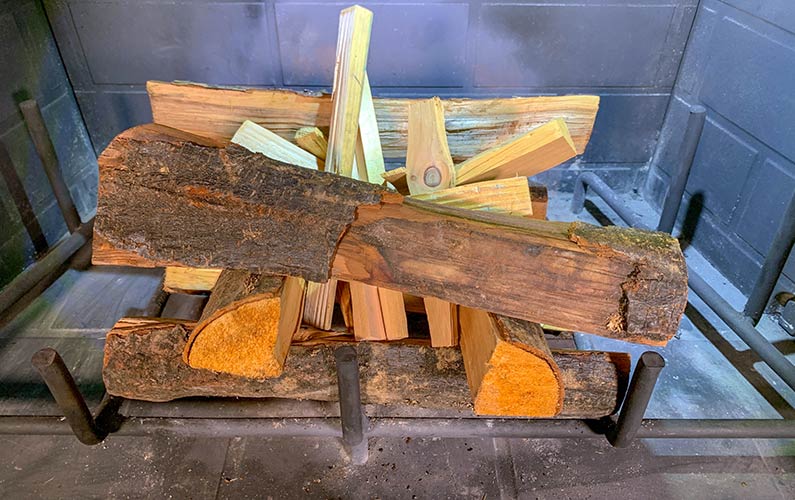Welcome to fire starting made easy! We’ll teach you how to build and start a fire in your fireplace using wood.
Overview
- Start with a safe fireplace and chimney with a spark screen and a grate.
- Gather the three essential fuels to prepare for ignition.
- Open the flue damper.
- Set up logs, kindling, and tinder using the upside-down fire method.
- Light the kindling; be on the watch for smoke spillage.
- Add seasoned wood logs, as the fire consumes the firewood.
- Keep watch of the fireplace (and don’t forget to enjoy it)!
Fireplace Fires Start with Safety
Having a successful fire in your fireplace is second to none. It provides enjoyment on a cold winter day and can be a cozy time with family and friends with a bit of preparation.
If you’ve ever struggled to get wood to start burning, then the thought of building a fire is often avoided. But it doesn’t have to be this way!
Read on and learn the tips and tricks from a master sweep who’s been helping customers with their fireplace and chimney needs for over thirty years. Fireplaces are to be enjoyed, but occasionally they become the source of household accidents. To keep the flame in its place we must take a few precautions to keep your home and family safe.

Should you find a home fire has advanced, don’t fight it! Evacuate your home and call 911 immediately.
Fire Extinguishers are a Must-Have When Burning Wood
Being able to address a small home fire in the first few moments is often the difference between life and death. If we’re having a fire in the home’s fireplace, we need to be able to respond quickly if that fire spreads beyond the hearth.
Thousands of times a year, wood-burning stoves and fireplaces are the starting point of house fires. Having a way to take care of trouble quickly is a necessity.
Spark Screens
Because burning wood produces flying sparks and embers, a spark screen for your fireplace opening is needed. Keeping the flames contained in the firebox protects your home surroundings from accidentally igniting. It may even protect the floor beyond the outer hearth.
A spark screen can be free-standing or attached to the front of the fireplace. They will allow movement when you want to add a log but easily closed to contain the blaze.
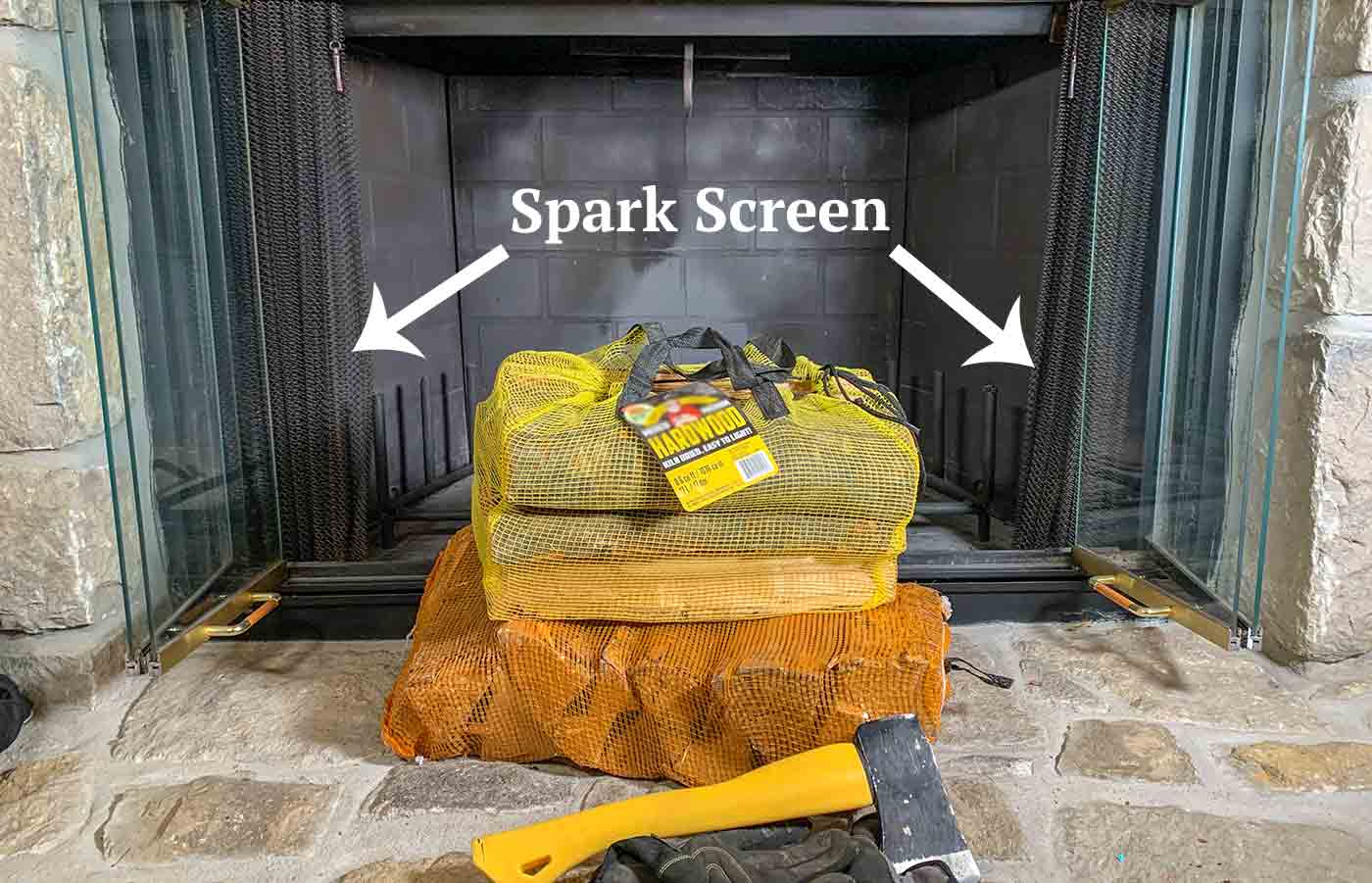
Iron Grate for the Logs
A way to keep the logs off the inner hearth of the fireplace and to keep them from moving around is the job of the fireplace grate. As a golf tee helps a golf ball stay in place, so the grate keeps the logs from rolling around the fireplace or worse, tumbling out into the room!
Fireplace grates help in other ways too. By elevating our wood logs, air can easily enter the combustion zone and travel upward through the fuel, making our logs burn easier.
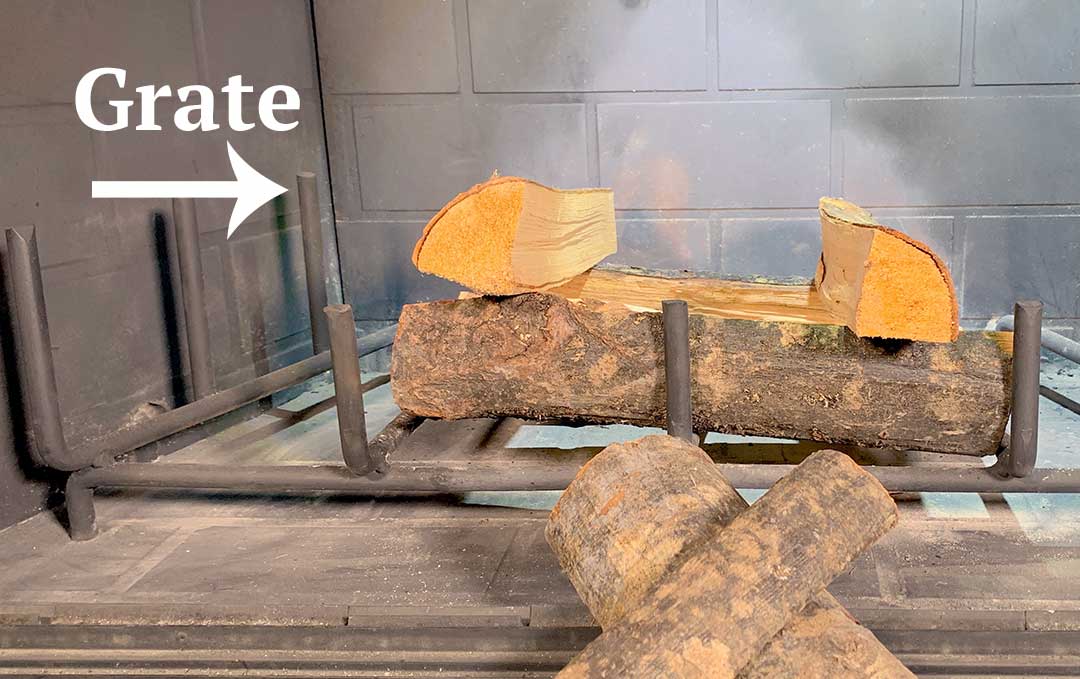
Since grates have wide spacing between their bars, ash can easily fall out of the way, allowing free air movement to keep things burning.
When starting wood-burning fires in a wood stove, the grate is often not a requirement and is not recommended by the manufacturer. However, all other steps (chimney cleaning, kindling, and tinder) are the same. Follow these steps, and you’ll be cozy in no time!
Get the Chimney Cleaned and Inspected
Getting your chimney swept and inspected is often the forgotten step toward safe, successful fires in the fireplace. Why? A flue that is coated with creosote and soot will not draw air into the fireplace to keep the combustion going. Creosote is a danger, as well as it is a common cause of hazardous chimney flue fires. Which severely damages flue tiles inside chimneys and often spreads to the roof and home.
Cleaning is only part of the reason to have a visit from your Certified Sweep. Chimneys need to be examined for animal nests or other clogs that may have gotten in over the last year.
As sturdy as they are, even masonry flues will develop gaps and cracks that may allow the byproducts of combustion to reach the home.
By following the advice of the NFPA211, CSIA, and countless insurance companies, annual chimney maintenance is a must to enjoy a fireplace to its full potential…without unnecessary risk.

There are many types of store bought fire starters to choose from. Check your local hardware stores for various brands available in your area. Experiment and use what works best for you.
Avoid Liquid Fire Starters
A word of caution, never use charcoal lighter or other liquid accelerants in your fireplace. Because liquids can easily spread across surfaces. All too often, homes and people have suffered from the use of such products. If accelerants were to leak into a crevice below the firebox, they could lead fire to adjacent combustibles (walls, ceilings, floors, etc.)
Another danger with liquid fuels (kerosene, gasoline, diesel oil) is the danger of rapid combustion or explosion. To be safe and not sorry, keep volatile accelerants away from your fireplace or woodstove.
Firewood, Tinder, and Kindling
Those of us who have tried to start a fire with round logs and newspapers, we’ve often had a smokey failure trying to get wood to stay lit in the fireplace.
To successfully get a fire going, you must begin with the right fuel. In the case of a wood fire, we want wood that will easily catch on, and keep burning until the fire gets established.

Make your own tinder and kindling for free with dryer lint and split-wood and shavings. See the short video below to watch how well this setup starts and burns. You’ll never build a fire the same way again!
Tinder
Dryer lint, pine cones, fine shavings of pine wood are all examples of Tinder that will begin to burn with only one match. When fire building in the fireplace, using tinder we quickly ignite the kindling and heat up the chimney to start the draft.
A popular option for kindling is commercial fire starters often used for BBQs and camping. These pre-made starters are often made of paraffin and paper, causing them to light quickly and reliably.
For a more natural fire starter, consider trying fatwood. Fatwood is from the heart of a pine tree and is loaded with resin-impregnated wood, making it a great fire starting tinder fuel.
Not Just Any Log, but Seasoned Split Hard Firewood
You’ll want to choose logs for the fire that will light early, but not contribute to creosote build-up. Fortunately, there are a variety of hardwoods available, suitable to burn in your fireplace or woodstove. By choosing logs from hardwood trees, we’ll get more heat, minimize creosote build-up, and make burning wood in the fireplace a pleasure. Visit our helpful resource on choosing the Best Wood to Burn.
Less creosote and easier fires? Let’s get some of that seasoned split wood!
Preparing the Firewood for Burning
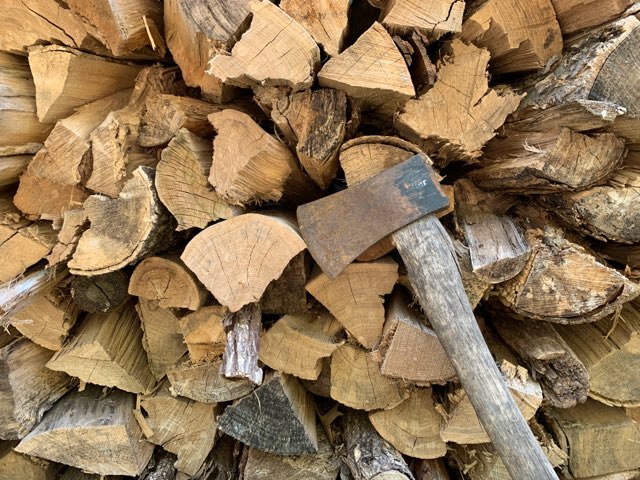
When your log was still a tree, it was full of moisture, while water was good for the growing tree, it’s a hindrance to our plans for a building a wood fire. Splitting your logs helps in two ways, the smaller pieces will dry sooner in the woodpile, and with the wood splintered and cracked, it will engage the flame from the kindling much more likely.
Truth be told, it’s almost impossible to burn a round, damp bark-covered log. And if it ever does begin to burn, it will smolder thick smoke for a long time, and it is this smoke that causes creosote.
Build the Fire on the Grate
Now that you have the right fuel, let’s assemble our fire in the best way to first encourage our flames/combustion to progress through the logs without stopping and then start the draft immediately. Great fires begin on the fire grate!
The Upside-Down Fire Building Method accomplishes both these goals.
By setting our logs 90° to each other, we encourage ample combustion air movement, and by building our tinder and kindling pile on to, we put heat up the flue to establish our draft.
Start with:
- Seven split dry logs
- Enough kindling to fill the open square hole between the logs
- Sufficient tinder that will burn at least 10 minutes
- Build the log pile as explained, with larger logs on the lowest row (on the grate) and the more slender ones on top.
- Position the logs with bark to the outside, and split splinter wood to the inside.
- Stage the pieces of kindling at a 45° angle inside the logs, if careful, they will catch on the edges of the logs without many falling through.
- Nestle the tinder (or fire starter) among the kindling on top.
You’re only concerned with catching a few pieces of kindling on fire with the tinder. The rest of the wood will ignite as the fire burns downward.
As the tender and kindling become fully engulfed, you will see, hear and smell the drying and charing of the top two logs. In short order, these logs will begin to contribute to the fire, as their slender split edges begin to burn.
Check for any smoke spillage during this time, as the chimney may have trouble getting its draft established. If a little smoke begins to come into the home, this can often be remedied by opening a door or window on the windward side of the home (the side of the home that the wind blows against).
Once the chimney flue has warmed, the door can be shut. Sometimes, all it takes is a few minutes of outdoor air to make a fireplace behave!
Watch a quick fireplace burning demonstration (video 20x speed). Notice how the lit tinder and kindling ignite first, then the flames spread to the wood logs behind a spark screen for safety. What you see in this video is the “Upside Down Fire Method” as built and described on this page.
Kindling Transitions the Flame from Tinder to Logs
Tinder gives us quick combustion and heats up the flue to start the draft, but it lacks the ability to keep the fire going as it is usually used up in a few minutes. This is where kindling comes in. Kindling burns slower than tinder, but faster than logs.
By having kindling as a transition fuel, we can dry the small pieces of firewood and get them to char, making their ignition more likely. Without the drying and pyrolysis of the logs, our firewood will never move to the combustion stage.
Our kindling also helps in another way. It gives us a bed of embers and coals adding to the heat of your firebox. The smolder in our fuel load and below the grate adds to the needed heat to maintain the draft in the flue, and in turn, draws in fresh combustion air. Of all the steps in building a fire, kindling is the one so often overlooked. Newspaper under logs is a receipt for a cold, but smokey evening.
Stick Around for Enjoyment and Safety
An operating fireplace or woodstove is an ancient appliance that is often very self-sufficient, only occasionally needing to rearrange the logs, add wood or roast a marshmallow. Mindful wood burners stand watch, making sure smoke and flames stay in the fireplace and don’t spread into the home.
It should not be considered a chore, rather a relaxing indulgence! This can be done with friends and family while enjoying games or the company of your guests… or maybe even a book and moment alone.
IF we properly maintain the chimney AND all its parts, then our fireplace will work as intended.
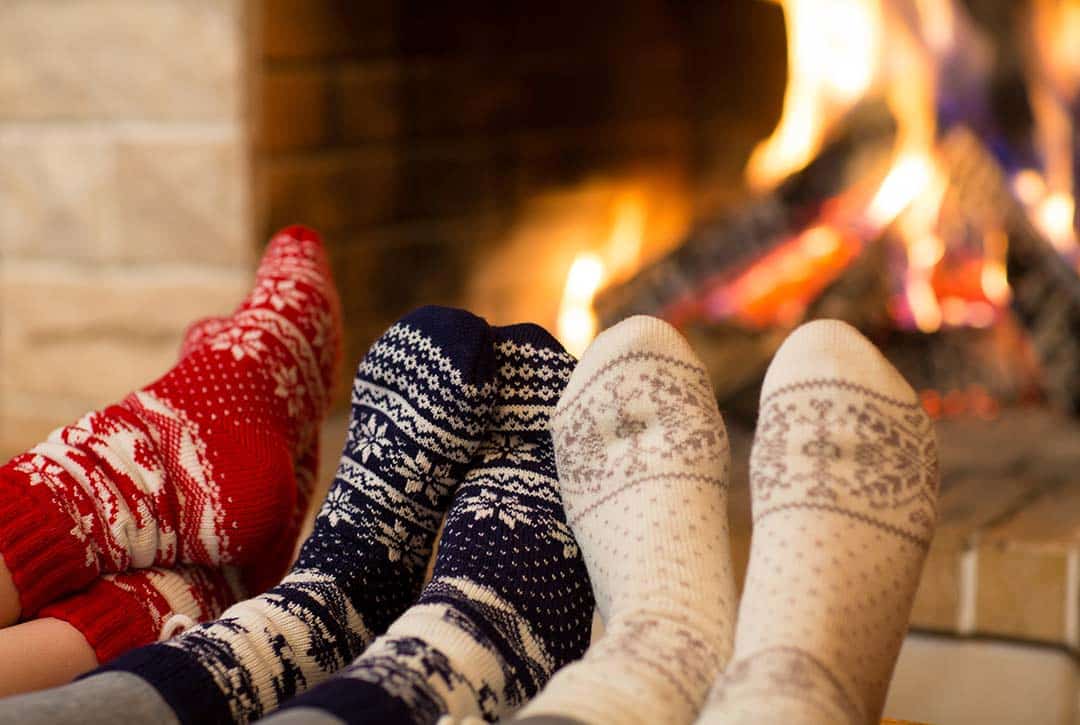
Conclusion
In many homes, fireplaces are seldom enjoyed, because getting a delightful wood blaze going can be a challenge. As we see above, there are a few steps to prepare the fireplace, chimney, and firewood, that if taken, make this task easier. Starting with a safe fireplace and chimney ensures your system will perform as needed to keep the flames rolling nicely.
Selecting the best wood for burning is a must. Since logs that are damp or green just will not ignite or keep burning. Wood for our fireplace needs to be split and dried in our wood storage area for a few months to minimize excessive creosote build-up. Which makes starting and maintaining your fire a quicker and more relaxing experience!
Next, preparing your tinder and kindling is a step that will give us a good draft quickly and make the beginning of lighting a fire a “one match” success. Isn’t it time for you and your family to start building memories and fires at your hearth? Winter is around the corner, and any evening without a fire in the fireplace is a pleasant opportunity missed.
If you’re in our local Kansas City area, and not sure whether your fireplace is safe to use, then give us a call at 913-642-6171 today!

